
The Sabine River is a 360-mile (580 km) long river in the Southern U.S. states of Texas and Louisiana, From the 32nd parallel north and downstream, it serves as part of the boundary between the two states and empties into Sabine Lake, an estuary of the Gulf of Mexico.
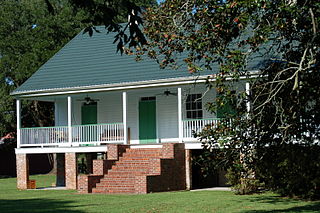
West Baton Rouge Parish is one of the sixty-four parishes in the U.S. state of Louisiana. Established in 1807, its parish seat is Port Allen. With a 2020 census population of 27,199 residents, West Baton Rouge Parish is part of the Baton Rouge metropolitan statistical area.

Sabine Parish is a parish located in the U.S. state of Louisiana. As of the 2020 census, the population was 22,155. The seat of the parish is Many.

Cameron Parish is a parish in the southwest corner of the U.S. state of Louisiana. As of the 2020 census, the population was 5,617. The parish seat is Cameron. Although it is the largest parish by area in Louisiana, it has the second-smallest population in the state, ahead of only Tensas. Cameron Parish is part of the Lake Charles metropolitan statistical area.

Beauregard Parish is a parish located in the U.S. state of Louisiana. As of the 2020 census, the population was 36,549. The parish seat is DeRidder. The parish was formed on January 1, 1913.
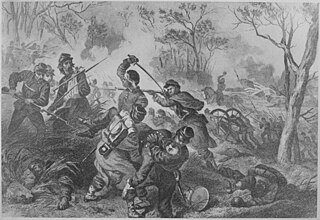
The siege of Port Hudson was the final engagement in the Union campaign to recapture the Mississippi River in the American Civil War. While Union General Ulysses Grant was besieging Vicksburg upriver, General Nathaniel Banks was ordered to capture the lower Mississippi Confederate stronghold of Port Hudson, Louisiana, to go to Grant's aid. When his assault failed, Banks settled into a 48-day siege, the longest in US military history up to that point. A second attack also failed, and it was only after the fall of Vicksburg that the Confederate commander, General Franklin Gardner, surrendered the port. The Union gained control of the river and navigation from the Gulf of Mexico through the Deep South and to the river's upper reaches.
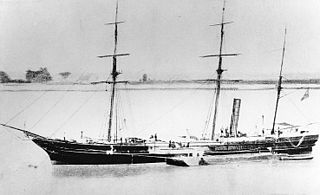
CSS McRae was a Confederate gunboat that saw service during the American Civil War. Displacing around 680 tons, she was armed with one 9-inch (229 mm) smoothbore and six 32-pounder (15 kg) smoothbore cannon.

The Battle of Mansfield, also known as the Battle of Sabine Crossroads, on April 8, 1864, in Louisiana formed part of the Red River Campaign during the American Civil War, when Union forces were attempting to occupy the Louisiana state capital, Shreveport.
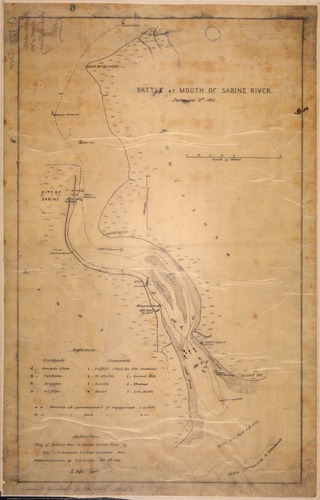
The Second Battle of Sabine Pass was a failed Union Army attempt to invade the Confederate state of Texas during the American Civil War. The Union Navy supported the effort and lost three gunboats during the battle, two captured and one destroyed.

The New Orleans Massacre of 1866 occurred on July 30, when a peaceful demonstration of mostly Black Freedmen was set upon by a mob of white rioters, many of whom had been soldiers of the recently defeated Confederate States of America, leading to a full-scale massacre. The violence erupted outside the Mechanics Institute, site of a reconvened Louisiana Constitutional Convention. According to the official report, a total of 38 were killed and 146 wounded, of whom 34 dead and 119 wounded were Black Freedmen. Unofficial estimates were higher. Gilles Vandal estimated 40 to 50 Black Americans were killed and more than 150 Black Americans wounded. Others have claimed nearly 200 were killed. In addition, three white convention attendees were killed, as was one white protester.
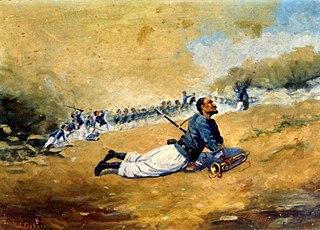
Louisiana Tigers was the common nickname for certain infantry troops from Louisiana in the Confederate army during the American Civil War. Originally applied to a specific company, the nickname expanded to a battalion, then to a brigade, and eventually to all Louisiana troops within the Army of Northern Virginia. Although the exact composition of the Louisiana Tigers changed as the war progressed, they developed a reputation as fearless, hard-fighting shock troops.

The 4th Arkansas Infantry was a Confederate States Army infantry regiment from the state of Arkansas during the American Civil War. The 4th Arkansas served throughout the war in the western theater, seeing action in the Kentucky, Tennessee and Georgia campaigns. Following its depletion in numbers the regiment was consolidated several times with other Arkansas regiments, finally merging in 1865 into the 1st Arkansas Consolidated Mounted Rifles. Another Arkansas unit also had the designation 4th Arkansas, the 4th Regiment, Arkansas State Troops which participated in the Battle of Wilson's Creek, but was never transferred to Confederate Service. There is no connection between the two units.
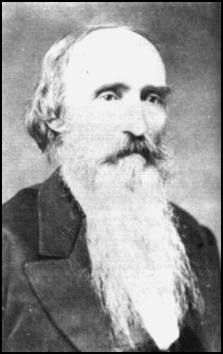
Claudius Wistar Sears was a United States Army officer, an educator, and a Confederate general during the American Civil War.
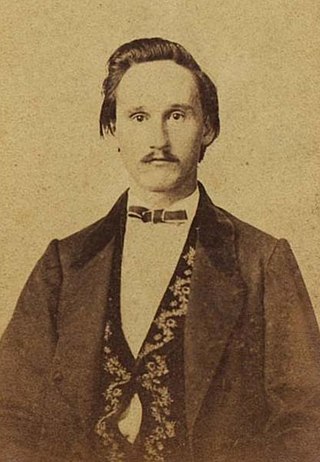
The 10th Arkansas Infantry (1861–1865) was a Confederate Army infantry regiment during the American Civil War from the state of Arkansas. The unit is also known as A. R. Witt's Infantry, C. M. Cargile's Infantry, E. L. Vaughan's Infantry, Thomas D. Merrick's Infantry, S. S. Ford's Infantry, Obed Patty's Infantry, George A. Merrick's Infantry, Zebulon Venable's Infantry and Robert C. Bertrand's Infantry in contemporary accounts. After being captured at the Siege of Port Hudson, the unit reorganized as a mounted infantry unit, and was known as the 10th Arkansas Cavalry Regiment or Witt's Arkansas Cavalry.
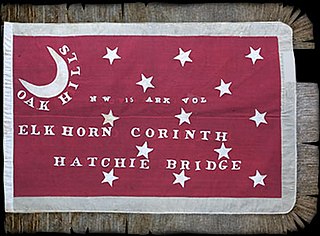
The 15th (Northwest) Arkansas Infantry Regiment (1861–1865) was a Confederate Army infantry regiment during the American Civil War. The unit was originally formed as the 3rd Arkansas Infantry Battalion. After receiving the required 10 companies, the unit was redesignated as the 21st (McRae's) Arkansas Infantry Regiment. Upon recognition that there was already a 21st Arkansas, the unit was again redesignated as the 15th Arkansas Infantry Regiment. This was the third Arkansas unit to bear the designation "15th Arkansas". The others are the 15th (Josey's) Arkansas Infantry Regiment and the 15th (Gee/Johnson) Arkansas Infantry Regiment. The unit saw action both west and east of the Mississippi, before serving in the Vicksburg campaign. The regiment was surrendered at Vicksburg in July 1863. After being paroled and exchanged, the regiment was consolidated with other depleted Arkansas regiments to form the 1st (Trans-Mississippi) Arkansas Consolidated Infantry Regiment.
The 18th Arkansas Infantry Regiment or Carroll's Arkansas Infantry Regiment was an infantry formation of the Confederate States Army during the American Civil War. The regiment was raised in April 1862 under the command of Colonel D. W. Carroll. It served east of the Mississippi in several actions before being surrendered at Port Hudson in July 1863. Reorganized, the regiment was finally merged with several other Arkansas units to form the 2d Consolidated Arkansas Infantry. There was another regiment designated as the 18th Arkansas. When Lieutenant-Colonel J. S. Marmaduke's 1st Arkansas Infantry Battalion was increased to a regiment, it was briefly designated as the 18th Arkansas Infantry. Marmaduke's regiment was subsequently redesignated as the 3d Confederate Infantry.
The 12th Arkansas Infantry (1861–1865) was a Confederate Army infantry regiment during the American Civil War. The regiment spent much of its service defending Confederate strong points along the Mississippi River. The unit participated in the defense of Island No. 10 in early 1862 and later became part of the garrison of Port Hudson in 1863. Following the capitulation of the garrison of Port Hudson, the survivors of the 12th were eventually paroled and exchanged back to Arkansas where the regiment was consolidated with the remnants of several other Arkansas regiments to become the 2nd Arkansas Consolidated Infantry Regiment.

The 22nd Arkansas Infantry Regiment was a Confederate Army infantry regiment during the American Civil War (1862–1865). This regiment was originally organized as the 17th Arkansas Infantry Regiment, reorganized after the battle of Pea Ridge as 1st Regiment, Northwest Division, Trans-Mississippi Department, or Rector's War Regiment, redesignated as the 35th Arkansas in the summer of 1862, and reorganized and redesignated as the 22nd Arkansas following the Battle of Prairie Grove. The unit was also sometimes referred to as, King's Arkansas Infantry or McCord's Arkansas Infantry. This was the second regiment to be officially designated as the 22nd Arkansas. The first was mustered in at DeValls Bluff, Arkansas, on April 9, 1862, and later reorganized as the 20th Arkansas Infantry Regiment.

Between 1861 and 1865, American Civil War prison camps were operated by the Union and the Confederacy to detain over 400,000 captured soldiers. From the start of the Civil War through to 1863 a parole exchange system saw most prisoners of war swapped relatively quickly. However, from 1863 this broke down following the Confederacy's refusal to treat black and white Union prisoners equally, leading to soaring numbers held on both sides.

The Civil Service Rifles War Memorial is a First World War memorial located on the riverside terrace at Somerset House in central London, England. Designed by Sir Edwin Lutyens and unveiled in 1924, the memorial commemorates the 1,240 members of the Prince of Wales' Own Civil Service Rifles regiment who were killed in the First World War. They were Territorial Force reservists, drawn largely from the British Civil Service, which at that time had many staff based at Somerset House.

















